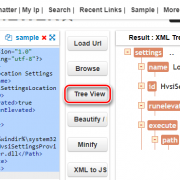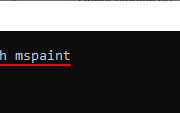Поднятие tftpd32 сервера на windows
Содержание:
- Solarwinds Free TFTP Server
- Как передавать файлы в сети TFTP
- Spiceworks TFTP Server
- TFTP Server Configuration
- 3 простых шага по исправлению ошибок SOLARWINDS-TFTP-SERVER.EXE
- Troubleshooting
- Final Words
- Peer-to-peer transfer
- Как проверить работу сервера tftpd32?
- Установка и настройка TFTP сервера
- Установка atftp в Linux
- TFTPD32/64
- Соображения безопасности
- What is TFTP Recovery over Ethernet?
- PC Functioning as an FTP Server
- Authentication
- [edit] General
- PC Functioning as a TFTP Server
- What is TFTP?
- WinAgents TFTP Server
- Starting new transfer
- ⚡ What is TFTP used for?
Solarwinds Free TFTP Server
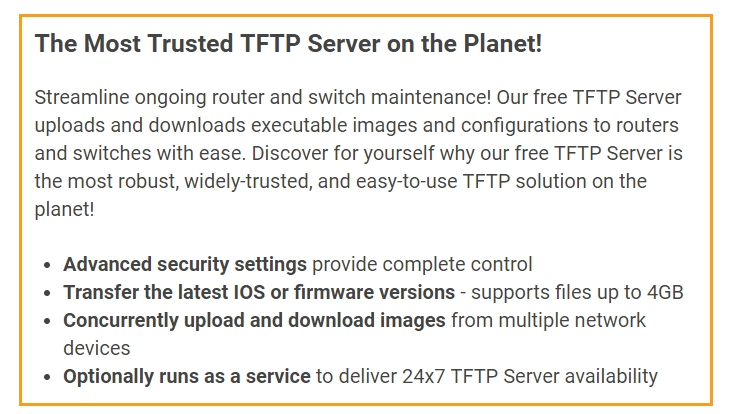
Solarwinds offers a full suite of IT and network management software. Their free TFTP server is a stripped-down version of their Network Configuration Manager product, but it functions well for basic tasks like pushing out OS images to workstations or firmware to network devices periodically over an internal network.
It can handle files as large as 4 GB, concurrent transfers to many devices at once, and runs as a Windows service. It doesn’t have more advanced features like device backup and version control or change management tools, but it does manage which IP numbers are authorized for connections.
Как передавать файлы в сети TFTP
После установки клиента и перенаправления порта перейдем к передаче файлов. Убедитесь, что сервер запущен, затем следуйте инструкциям:
Нажмите Win + R, в диалоговом окне наберите cmd для вызова командной строки. Перенесите или скопируйте файлы, которые хотите передать, в корневой каталог сервера.
Для отправки файлов нужно использовать параметр PUT, при получении GET. Синтаксис команды выглядит следующим образом:
Например, для передачи используйте команду:
Если хотите получить файл, то команда будет выглядеть:
Если хотите переслать на удаленное устройство за пределами сети, нужно указать публичный IP-адрес в командной строке, а затем порт. Примером может быть:
Spiceworks TFTP Server
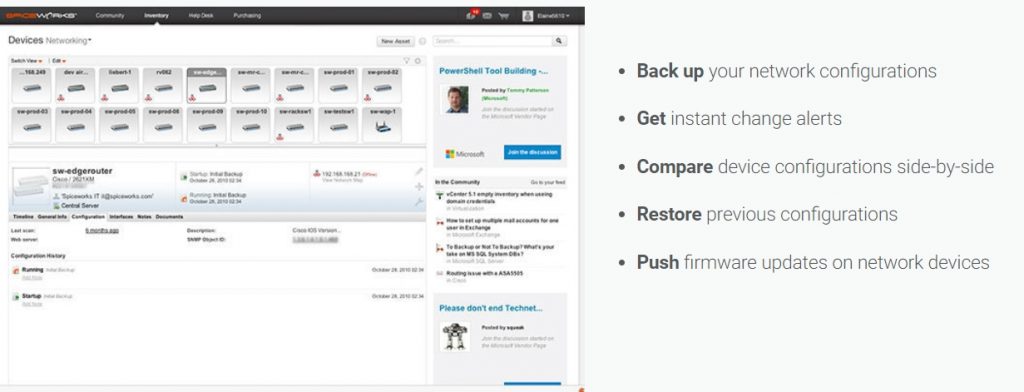
Spiceworks is a well-known networking and IT community with various relevant software tools as well.
One of their offerings include a network administration app that bundles a TFTP server for network configuration tasks.
The app includes an inventory tab that gives you a snapshot of all your network devices and workstations.
It includes an interface for scheduling file transfers like backups, configuration restore files, and firmware updates.
SpiceWorks also provides advanced features like comparing a device’s current software configuration with a backup to detect changes that have been made.
Whether you need to reset your workstations to a software configuration periodically or just want to schedule safe backups for repairing errors in the future, SpiceWorks can handle your TFTP server needs.
You will need to register and create an account in order to download.
TFTP Server Configuration
Once you install the TFTP server, it will start running as a daemon and ready to receive and send files. By default the TFTP uses port 69. tftpd-hpa uses the directory “/srv/tftp” for uploading and downloading. To change that, you must edit the following configuration file:
netbeez.net$ cat /etc/default/tftpd-hpa
# /etc/default/tftpd-hpa
TFTP_USERNAME=»tftp»
TFTP_DIRECTORY=»/srv/tftp»
TFTP_ADDRESS=»0.0.0.0:69″
TFTP_OPTIONS=»—secure»
|
1 2 3 4 5 6 7 |
netbeez.net$catetcdefaulttftpd-hpa # /etc/default/tftpd-hpa TFTP_USERNAME=»tftp» TFTP_DIRECTORY=»/srv/tftp» TFTP_ADDRESS=»0.0.0.0:69″ TFTP_OPTIONS=»—secure» |
The “- -secure” option adds security to TFTP by limiting all transactions in the TFTP_DIRECTORY. In addition, files can be uploaded in “/srv/tftp” only if they already exist in that directory and are publicly writable. If you want to allow TFTP clients to upload new files in “/srv/tftp” then you need to add the “- -create” option like this: TFTP_OPTIONS=”- -secure – -create”. After you edit “/etc/default/tftpd-hpa”, restart the tftp server with “service tftpd-hpa restart”.
3 простых шага по исправлению ошибок SOLARWINDS-TFTP-SERVER.EXE
Файл solarwinds-tftp-server.exe из SolarWindsNet является частью TFTP Server 5 0. solarwinds-tftp-server.exe, расположенный в Unknown file path с размером файла 8110000.00 байт, версия файла 5.0. подпись not found.
В вашей системе запущено много процессов, которые потребляют ресурсы процессора и памяти. Некоторые из этих процессов, кажется, являются вредоносными файлами, атакующими ваш компьютер. Чтобы исправить критические ошибки solarwinds-tftp-server.exe,скачайте программу Asmwsoft PC Optimizer и установите ее на своем компьютере
Всего голосов ( 21 ), 3 говорят, что не будут удалять, а 18 говорят, что удалят его с компьютера.
Troubleshooting
TFTP file transfer doesn’t work from local computer
- Check if your TFTP server is running and listening
- Check if TFTP folder is set up correctly (location, access rights)
- Check if firmware file is set up correctly (location, access rights)
TFTP file transfer works from local computer, but not from another computer:
- Check if network cable is connected properly
- Check if server IP is set correctly
- Make sure server firewall allows inbound TFTP on UDP port 69
TFTP file transfer works from another computer, but not from router:
- Check if server IP is set correctly (same as router is searching for)
- Try using alternate cable, a crossover cable or alternate switch/speed
- Try connecting to an alternate port on the router / routers switch
- Pay attention to any output or verbosity from the router console or led activity if available
- Verify the arp cache on either host… server side is easier…
- Use arp -s to add a static mapping or arp -d to delete stale entries…
- Use a third host to simply ping the router, both with static addresses if possible
- Try an alternate server software, client software or TFTP transfer mode
- If you get some activity, timing can often yield results, power cycle the router and start the transfer earlier or later…
Final Words
TFTP is a terrific and often misunderstood transferring method.
Although it has a bad reputation for its lack of security, it doesn’t have much overhead, making it a reliable, quick, and easy transferring mechanism.
You can use it in enclosed LANs or WANs, where speed reigns over security.
Setting up a TFTP server on Windows 10 is straightforward. Just download Solarwinds TFTP Server and configure it, as shown in this tutorial.
If your TFTP client is a networking device, it will likely have the TFTP service already enabled. But if you want to transfer files to a Windows 10 workstation, you can enable the TFTP built-in feature.
We hope that this tutorial was informative.
Please comment if you have any questions about the setup and configuration of the TFTP on your Windows 10.
Peer-to-peer transfer
For peer-to-peer file transfers, a complication is that one or both peers may be
behind a NAT router or a firewall (NAT stands for network address translation).
Both NAT routers and firewalls often block unsolicited incoming network traffic.
If you run a server behind a NAT router or firewall, you must typically configure
the router and/or firewall manually.
Several proposals exist for automatic configuration of NAT routers and firewalls
(UPnP, SOCK5, MIDCOM), but none is widely used. However, most NAT routers and
firewalls do support a technique called «UDP NAT traversal» or «UDP hole
punching». As the name implies, this technique works with the UDP protocol; it
is standardized in RFC 3489.
There is some experimental success in making TCP hole punching work, but the
TCP variety is much more dependent on a particular implementation of the TCP/IP
protocols in a router. NAT traversal works far more reliably with UDP.
NAT traversal requires a «rendez-vous» server, typically called a «STUN» server.
TFTP uses UDP as the transport protocol, rather than TCP. As such, peer-to-peer
file transfer may be more easily and more reliably implemented with TFTP than
with FTP, HTTP or other protocols based on TCP. Another advantage is that the
implementation of TFTP clients and TFTP servers are similar, and it is therefore
easy to build combined client/server hosts.
There is one issue with the TFTP protocol that hinders NAT traversal: according
to RFC 1350, the client
should choose a pseudo-random port number and send its request to the well-known
TFTP server port number 69. For its reply, RFC 1350 states, the server should
choose a new pseudo-random port number. That is, the server receives a request
at port 69, but it sends its reply from, say, port 4362. NAT routers and firewalls
may block this: a reply from port 69 would pass (because it was solicited) but
a reply from a different port might not pass —this depends on the rules that a
NAT router and/or firewall use;
RFC 3489,
describing STUN, describes four classes of NAT routers.
The reason that RFC 1350 describes the protocol as such, is for ease of
implementation. A TFTP client should be prepared to receive a reply from a TFTP
server at a different port then where the request was sent (only or
read-requests and write-requests, by the way). However, there is no fundamental
reason that the server must choose a different port. It is just
simpler to implement a TFTP server where all data transports run over unique
ports, because the demultiplexing of the network packets then happens in the operating
system. When the TFTP server returns all replies over the well-known port 69,
it must demultiplex incoming packets itself, using the source IP and port
addresses. In fact, this is precisely how
Weird Solutions made their
«TFTP Turbo» product firewall-friendly and NAT-enabled. Other TFTP servers use
a similar design (e.g. «Open TFTP Server»,
«Managed TFTP server»).
Как проверить работу сервера tftpd32?
Для того, чтобы передать файл необходимо открыть cmd.exe и выполнить команду:
Для того, чтобы получить файл с tftp-сервера, есть команда:
Использовать tftpd32/tftpd64 для каких-то постоянных задач не рекомендуется, так как у него практически нет никакой защиты от несанкционированного подключений к серверу. Да, можно ограничить доступ к нему только определенным IP-адресам, но та легкость, с которой можно подменить IP-адрес, позволяет сказать, что это не относится к сетевой безопасности вообще.
Включать сервер tftp с таким «уровнем безопасности» можно только на короткое время, для выполнения каких-то сервисных работ, а лучше вообще делать это в изолированной сети.
Установка и настройка TFTP сервера
В данной статье рассматривается:
TFTP (англ. Trivial File Transfer Protocol — простой протокол передачи файлов) используется главным образом для первоначальной загрузки бездисковых рабочих станций. TFTP, в отличие от FTP, не содержит возможностей аутентификации (хотя возможна фильтрация по IP-адресу) и основан на транспортном протоколе UDP.
Основное назначение TFTP — обеспечение простоты реализации клиента. В связи с этим он используется для загрузки бездисковых рабочих станций, загрузки обновлений и конфигураций в «умные» сетевые устройства, записи статистики с мини-АТС (CDR) и аппаратных маршрутизаторов/файрволов.
Программа работает на порту 69 протоколы UDP и TCP.
Настраивать TFTP сервер мы будем для использования в процедуре обновления устройств.
Установка
В качестве программы, которая будет выполнять роль TFTP сервера будет небольшая программа, которую можно СКАЧАТЬ
Качаем portable edition версию т.к. лишняя возня с установкой нам не нужна. Выбираем исходя из ОС которая у вас установлена.
Распаковываем в удобное для нас место и запускаем tftpd64.exe или же tftpd32.exe если мы скачали 32 битную версию.
В принципе данных действий нам достаточно, чтоб начать работать с данным TFTP сервером. Данные загружаются и скачиваются из корневого каталога, который указан в пункте 1.
Дополнительные настройки
Функционал данной программы не ограничивается только TFTP сервером, но так же имеет дополнительный функционал. Мы рассмотрим лишь малую часть, что часто используется.
DHCP Server – необходим для выдачи динамических IP адресов для наших устройств.
Переходим на вкладку DHCP и вносим минимальные настройки
Настройки самого DHCP сервера
Настройки для клиентов, что будут получать адреса
DHCP сервер работает в границах одного широковещательного домена т.е. если сервер находиться за маршрутизатором, то адреса мы не сможем получать. Возможность получать адреса находясь за маршрутизатором в данной статье не рассматривается.
Установка atftp в Linux
Попытка установить сервер atftpd из репозиториев приведет к установке еще одного сервера — одного из супер-серверов inet — демона, запускающего программы по событию, в данном случае по факту появления на 69 порту UDP запросов на подключение. Вы скажите: «А что же тут плохого?». Вообщем-то ничего, но если вы используете Debian версии 8 и выше или Ubuntu версии 15.04 и выше, то вы наверняка слышали о SystemD. SystemD — новый менеджер инициализации, пришедший на смену init. На конец 2015 года поддержка SystemD не реализована для серверов TFTP — мы сделаем это вручную. Поэтому, лучше устанавливать TFTP сервер из исходных текстов и сразу перейти в соответствующий раздел нашей статьи, но если вы всё же решили поизвести установку atftpd из репозиторией комадой
apt-get install atftpd
незабудьте остановить подтянувшийся inet и, собственно, сам atftpd
systemctl stop atftpd inetd
А также выключить их
systemctl disable atftpd inetd
Для избежания недоразумений также рекоменду удалить скрипт запуска atftpd из /etc/init.d/
rm /etc/init.d/atftpd
И стереть его упоминание из конфигурационного файла inet с помощью, например редактора nano:
nano /etc/inetd.conf #удалите строчку, начинающуюся с tftp
Избежать всего этого поможет сборка TFTP сервера из исходных текстов. Для этого нужно скачать архив с исходниками например c сайта sourceforge с помощью wget
wget http://downloads.sourceforge.net/project/atftp/atftp-0.7.1.tar.gz #версия может отличаться
Распаковать архив:
tar -xzvf atftp-0.7.1.tar.gz #версия может отличаться
Перейти в каталог с распакованным содержимым
cd atftp-0.7.1 #версия может отличаться
Выполнить конфигурационный скрипт, указав в качестве папки назначения /opt/atftp (вы, конечно, можете выбрать любую другую папку)
./configure —prefix=/opt/atftp
Создать эту папку
mkdir /opt/atftp
Собрать atftp
make
И, наконец, собранные файлы, закинуть в папку назначения
make install
На последок почистим за собой
cd ..
rm -R atftp-0.7.1
и создадим символические ссылки на исполняемые файлы
ln -svi /opt/atftp/sbin/atftpd /sbin/
ln -svi /opt/atftp/bin/atftp /usr/bin/
TFTPD32/64
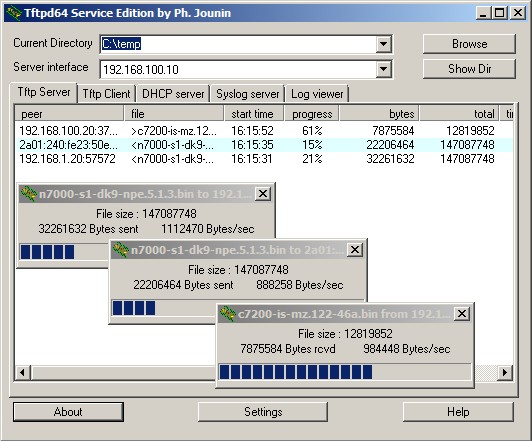
TFTPD32 or TFTPD64 is the 32-bit or 64-bit Windows version of a French open source network utility package that includes a TFTP server. The services provided in addition to the TFTP server include DHCP, Syslog server, log viewer etc. A TFTP client is also in the package if you need one to install on network devices receiving files.
TFTPD32/64 is the brainchild of Phillipe Jounin, who has made it available to the public under the European Union Public License. It’s been implemented in projects like Cisco’s PIX and Aironet, HP’s Alpha servers, and Juniper’s Netscreen. It also won CNET’s Five Star Award in 2009 and is probably the oldest utility of its kind.
Соображения безопасности
TFTP не включает механизмов входа в систему или контроля доступа
Необходимо соблюдать осторожность при использовании TFTP для передачи файлов, когда требуются аутентификация, контроль доступа, конфиденциальность или проверка целостности
Обратите внимание, что эти службы безопасности могут быть предоставлены выше или ниже уровня, на котором работает TFTP
Также необходимо проявлять осторожность в правах, предоставляемых процессу сервера TFTP, чтобы не нарушать безопасность файловой системы сервера. TFTP часто устанавливается с такими элементами управления, что только файлы с общедоступным доступом для чтения доступны через TFTP
Также обычно запрещены перечисление, удаление, переименование и запись файлов через TFTP. Передача файлов по TFTP не рекомендуется, если присущие протоколу ограничения могут вызвать непреодолимую ответственность.
TFTP часто устанавливается с такими элементами управления, что только файлы с общедоступным доступом для чтения доступны через TFTP. Также обычно запрещены перечисление, удаление, переименование и запись файлов через TFTP. Передача файлов по TFTP не рекомендуется, если присущие протоколу ограничения могут вызвать непреодолимую ответственность.
What is TFTP Recovery over Ethernet?
On most devices, the vendor provided boot loader is a partition separated from the actual firmware. In case of a failed flash process or in case of a misconfiguration, the device’s boot loader usually is still untouched and fully working. It the boot loader has a built-in “TFTP recovery mode”, it enables to regain control of a device with a broken firmware partition, by allowing a recovery flash process (which will also reset your configuration to the device defaults).
For many routers the recovery works by starting a TFTP server on your computer. Then device with the broken firmware has to be started up in TFTP recovery mode. Some devices then will pull the network-provided firmware file over TFTP network protocol to the OpenWrt and hopefully recover with a successful emergency flash process.
Some devices do not have automatic pull function and they need manual TFTP copy commands in recovery mode to get firmware from TFTP and firmware install.
NOTE: Some other routers, e.g. many Netgear routers, have TFTP server on themselves, and the PC needs to act as TFTP client. The “TFTP recovery mode” can also mean that, so look carefully at info about your router to find out which method your router possibly supports.
The below article mainly advises on the “TFTP client at router” recovery.
PC Functioning as an FTP Server
Figure 5-13 Networking diagram
- Run the FTP server software on the FTP server and configure the FTP service.
As shown in , run an FTP server program on the PC, for example, wftpd32. Choose Security > Users/rights. In the dialog box that is displayed, click New User. In the dialog box that is displayed, set the user name to user and password to huawei. Set Home Directory to D:\FTP. Click Done to close the dialog box. Set the IP address of the PC to 192.168.0.2 and mask to 255.255.255.0.
Figure 5-14 Configure the FTP server
- Connect the switch and the FTP server.
- Connect the FTP server to Ethernet0/0/0 of the switch using a network cable.
- Configure the IP address 192.168.0.1/24 for Ethernet0/0/0.
<HUAWEI> system-view interface ethernet 0/0/0 [HUAWEI-Ethernet0/0/0] ip address 192.168.0.1 24
If a fixed switch uses VLANIF 10 to connect to the FTP server through GE0/0/1, the configurations are as follows:
<HUAWEI> system-view vlan 10 quit interface gigabitethernet 0/0/1 [HUAWEI-GigabitEthernet0/0/1] port link-type hybrid [HUAWEI-GigabitEthernet0/0/1] port hybrid untagged vlan 10 interface vlanif 10 ip address 192.168.0.1 24
- Check whether the switch and FTP server are connected.
[HUAWEI-Ethernet0/0/0] ping 192.168.0.2 PING 192.168.0.2: 56 data bytes, press CTRL_C to break Reply from 192.168.0.2: bytes=56 Sequence=1 ttl=128 time=4 ms Reply from 192.168.0.2: bytes=56 Sequence=2 ttl=128 time=3 ms Reply from 192.168.0.2: bytes=56 Sequence=3 ttl=128 time=18 ms Reply from 192.168.0.2: bytes=56 Sequence=4 ttl=128 time=3 ms Reply from 192.168.0.2: bytes=56 Sequence=5 ttl=128 time=3 ms --- 192.168.0.2 ping statistics --- 5 packet(s) transmitted 5 packet(s) received 0.00% packet loss round-trip min/avg/max = 3/6/18 msThe preceding information indicates that the switch and FTP server can communicate properly with each other.
The direct connection mode is used as an example here. For an indirectly connected network, ensure that there are reachable routes between the FTP server and client.
- Log in to the server (PC) from the switch using FTP.
[HUAWEI-Ethernet0/0/0] return <HUAWEI> ftp 192.168.0.2 Trying 192.168.0.2 ... Press CTRL+K to abort Connected to 192.168.0.2. 220 FTP Server ready. User(192.168.0.2:(none)):user //Enter the FTP user name user. 331 Password required for ftpuser. Enter password: //Enter the FTP password huawei. 230 User logged in.
- Run the put command to upload the required file to the FTP server (PC) or run the get
# Upload the configuration file to the FTP server (PC).
command to download the required file from the FTP server to the switch. Examples are as follows:
put vrpcfg.zip 200 Port command okay. 150 Opening ASCII mode data connection for vrpcfg.zip. 226 Transfer complete. FTP: 8174 byte(s) sent in 0.099 second(s) 82.56Kbyte(s)/sec.
You can find the vrpcfg.zip file in D:\FTP on the PC.
# Download the latest version of the system software to the switch. binary //Set the file transfer mode to binary.
200 Type set to I.
get devicesoft.cc
200 Port command okay.
150 Opening ASCII mode data connection for devicesoft.cc.
226 Transfer complete.
FTP: 93832832 byte(s) received in 722 second(s) 560.70byte(s)/sec.
It is recommended that the transfer mode should be changed to binary when the program files such as system software are transferred to ensure transmission reliability.
After the transfer is complete, run the dir command in the user view of the switch. You can find the file in the storage device.
Authentication
TFTP has no session control and you cannot «log in» onto a TFTP server. Traditionally,
files on a TFTP server can be accessed without password. Several Linksys routers
(e.g. WAG54G) use TFTP for updating firmware. To make sure that not anyone can do this,
Linksys made a minor adjustment to the protocol in which the initial transfer request
holds a password (in addition to the filename and the file mode).
Simply adding a password string to the TFTP read or write request has two problems.
Since the password is sent in clear-text it can easily be sniffed. A worse problem
is that this choice breaks option negotiation
(RFC 2347).
I feel that the password should be added to the request as an option, so that it
does not break option negotiation. There is no easy solution to avoid sniffing
the password, since the option negotiation must be initiated by the client and
it is just a two-way handshake. A full challenge-handshake protocol cannot be
built with TFTP option negotiation.
I propose the option «password» with a zero-terminated string as the parameter.
In case a user name and a password must be sent, these can be combined in the
string with a colon (or another «special» character) separating the user name
and the password. For example, in the parameter «thiadmer:secret», «thiadmer»
would be the user name and «secret» the password.
[edit] General
This article describes how to do an initial flash or a TFTP recovery flash for your device.
- Unplug the router, get a for the PC, and connect it via network cable to a router LAN port
- Set a fixed IP address on the PC with the same network as your router, e.g. Router: 192.168.1.1, PC: 192.168.1.2
- Setup the TFTP client, then start a continuous ping (-t switch is needed for this in Windows) to the router
- Plug in the router and start the TFTP client as soon as there is a TTL=100 ping response. The client should show transfer.
- TTL=64 means application code has been reached. If the router isn’t responding, it is soft-bricked (use OEM firmware)
- Read about timing problems below:
Special Asus TFTP Flashing Procedures
Some routers like the Asus WL-500xx series (WL-500G, WL-500G Premium, WL-500W, WL-500G Deluxe), need additional steps to perform a complete and proper initial flash. See this wiki page: Asus TFTP Flash
Special for Vista, Win7 and Win 2008
In order to catch the narrow window for TFTP flash, you should use platforms with simple TCP/IP implementations that don’t have CTCP implemented: Windows XP or Linux are reported to work, but some have reported significant problems with Vista, Windows 7 or Windows 2008.
For more information see this posting
Edit: While some may have reported problems, CTCP is definitely not the issue, because it is disabled by default in Windows Vista and Windows 7. So unless people are specifically turning it on, it isn’t running. I personally just used TFTP on my router with no difficulties, although mine is a Netgear WNDR3700 that was waiting for a TFTP flash and didn’t have this race condition at boot as some of these routers seem to. But again, even if you have an issue it’s not CTCP. Check out the wikipedia article on CTCP for information on how to check if it is running and how to disable it (both are simple command line entries).
If having issues, try connecting a separate network switch between the PC and router, so the PC network port sees a connection before the router port is up. This should allow for a faster ping reply. Then follow the instructions as normal.
Special for Linksys WRT54GL Users
If the router seems to be bricked so that the power light is constantly blinking and pinging the router results in TLL=100 continuously, then there is still a great chance that tftp can help.
Firstly you must flash the router with the original firmware available at Linksys homepage www.linksys.com, since flashing it with DD-WRT probably won’t give any result at all. Then do a 30/30/30 and after that you can flash with DD-WRT Mini. The initial flashing can be done with only the mini version, perhaps later you can move on to bigger versions of it.
PC Functioning as a TFTP Server
Figure 5-15 Networking diagram
-
Configure the PC as a TFTP server. Run the TFTP server program on the PC and set the working path to D:\tftpd32, as shown in .
The TFTP server program is not installed by default, and users must purchase and install the TFTP server software themselves. The TFTP32 software is recommended.
Figure 5-16 Configuring a TFTP server
- Connect the TFTP server and the switch, and configure IP addresses for them. For details, see «PC Functioning as an FTP Server».
- Run the tftp tftp-server put source-filename command to upload the required file to the TFTP server (PC) or run the tftp tftp-server get source-filename [ destination-filename
Upload the configuration file vrpcfg.zip to the TFTP server (PC) and save the file as vrpcfg1.zip.
] command to download the required file from the TFTP server to the switch. Examples are as follows:
<HUAWEI> tftp 192.168.0.2 put vrpcfg.zip vrpcfg1.zip Info: Transfer file in binary mode. Uploading the file to the remote TFTP server. Please wait...| TFTP: Uploading the file successfully. 8174 bytes send in 1 second.You can find the vrpcfg1.zip file in D:\TFTP on the PC.
What is TFTP?
Current FTP sessions support a lot of different commands. While logged in to an FTP server, users can usually list, delete, rename, upload, or download files and change directories. In contrast, TFTP offers only the ability to upload or download a file and uses UDP over IP instead of the more standard TCP/IP stack.
The protocol is not capable of allowing more advanced functionality but compensates by using the lockstep method of fault-tolerance that makes it extremely reliable. Due to this limited functionality, TFTP servers can have an extremely small footprint on the disk as well as in memory, making it ideal for use in embedded network devices.
Linux is far and away the most common operating system on the type of devices where you’re likely to encounter a TFTP server. But, there is also a rich ecosystem of Windows and macOS devices that run device firmware (think Apple TVs and Microsoft Surface for a few examples).
See also:
- Best SCP servers
- Best SFTP servers
WinAgents TFTP Server
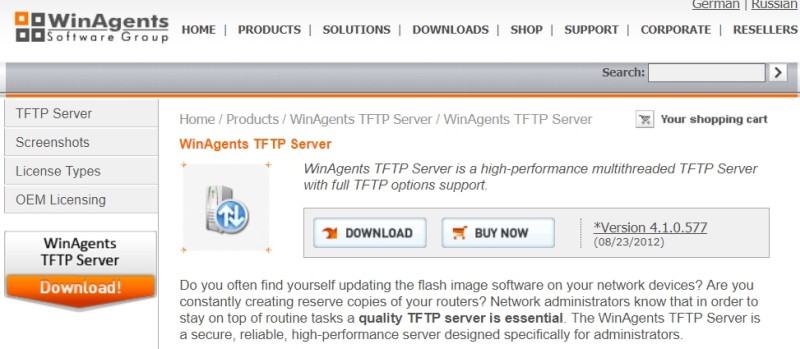
WinAgents Software Group offers free downloads of their TFTP Server. It’s a legacy software designed to run on Windows 2000, 2003, Vista, and 7, which makes it useful if you work with these older OSes on your network. It can probably work with Windows 10 as well, you just need to try it.
WinAgents TFTP Server operates as a background service and implements an IP-based access control model for some kind of network security.
It also supports sending files through firewalls by configuring a UDP port for the connections. Administrators who manage large intranets or remote sites will find the remote configuration features helpful. The cache system makes the system highly scalable compared to other free TFTP tools.
Starting new transfer
Assuming client does not already exist, we check if his filename contains two dots for parent directory access and if request file exists. Also we validate the transfer mode and only allow netascii and octet. Failure in any of these will result in an error package sent and the client won’t be added to our pool of clients. Otherwise, we read the next 512 bytes from the file and send the first package and also add him to the client pool (dictionary).
If he already exists he generally should not be sending more RRQ. If he does and clients block number is still at 1, we resend the first package up to some amount of resends. If they are reached we send an error and remove the client.
⚡ What is TFTP used for?
TFTP is widely used to transfer small files across LAN networks using UDP. It does not require much in the network resources. It is relatively easy to send files or firmware updates to devices throughout the network. Moreover, for conserving network resources, it makes it much easier to update device and firmware.
When you update the firmware of thousands of different devices on regularly it is not very efficient. A TFTP server also helps you to push firmware updates straight to these devices from a centralized location which means that you don’t require spending hours carrying out one task because you can use TFTP to automate the entire process.



